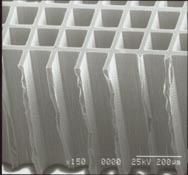
We are working on building and characterizing photonic crystals and cavities for terahertz (THz) radiation. The image above shows the vertical sidewalls of a Si photonic crystal prepared by deep reactivce ion etching clear through a silicon wafer at the UCSB Nanofabrication Center. The periodic change in index of refraction opens a band gap for light waves, in the same way the periodic potential of nuclei in a crystal sets up a band gap for electronic wave functions. The photonic crystal shown above has a band gap near 1 THz; the width of the band gap or stop band is over hundred gigahertz. Light with a frequency falling in the stop band cannot propagate in the plane of the crystal and is reflected. Photonic crystals can be used to create cavities which, like laser cavities, confine light in three dimensions. THz cavities and resonators have potential application for THz frequency discriminators, filters for use with high frequency electric oscillators (100’s of GHz), electron paramagnetic resonance, and physics experiments exploring the possibility of THz cavity quantum electrodynamics (QED). Conventional laser cavities use mirrors to confine light, but the volume of a laser cavity is large, so the electric field in the cavity is relativity weak. In order to strongly couple light to quantum states for QED experiments and quantum computation, the field should be as high as possible. For the same number of photons, the field strength can be increased by making the cavity smaller. A cavity with a small mode volume can be made by introducing a defect in a photonic crystal. The aim of our current research is developing THz photonic crystal cavities.